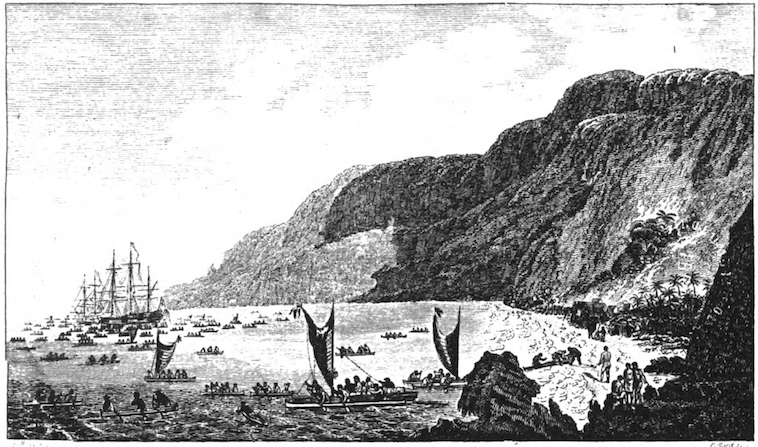The Journal of Isaak Iselin: Seeing landscape
 Drawing of Kealakekua Bay. Isaak Iselin would have known this picture, by the Anglo–Swiss painter John Webber (or Johann Wäber), because it was printed in the travelogue of Cook's third voyage.
Drawing of Kealakekua Bay. Isaak Iselin would have known this picture, by the Anglo–Swiss painter John Webber (or Johann Wäber), because it was printed in the travelogue of Cook's third voyage.
Cook, James and King, James. A Voyage to the Pacific Ocean, undertaken by command of his Majesty, (etc.). London: Printed for John Stockdale, (etc.), 1784, vol. 3, p. 268.
Die Transkription lautet:
On leaving the island of Owhyhee I must observe that I
have in many respects been disappointed in my visit there, particularly
as to its fertility & population; the land named Karakakoa
within several miles is stony & barren and it is with much trouble
that the natives raise their taro, potatoes, yams etc. which
they have to fetch a from the mountains at a considerable distance
The population seems to have much decreased, which as
already stated is owing to sickness & the absence of the king &
chiefs.
Context and Interpretation:
Upon leaving the Island of Hawaiʻi (Owhyhee) on June 26th 1807, Iselin expresses disappointment in the fertility around the Bay of Kealakekua (Karakakoa). It seems that his expectations of the island, based on the texts and pictures in the travelogues of James Cook, George Vancouver and others who had described the vicinity of Kealakekua, did not accord with his own experiences.
Iselin refers to a decrease in population. He explains this by referring both to the campaign of Kamehameha I, which caused warriors and their families to move away, and by mentioning epidemics (influenza, venereal disease, etc.). Significantly, Iselin does not mention who was responsible for the outbreak of disease, namely EuroAmerican visitors like himself. Post–contact epidemics indeed caused the decimation of the Hawaiian population.
Throughout his journal, Iselin uses the English nomenclatura common at the time for places and names in the Hawaiian Islands (then known as the Sandwich Islands). Here, Owhyhee stands for the Island of Hawaiʻi (Big Island) and Karakakoa for Kealakekua Bay.
